Where did RBI's expected Rs 30,000-crore more surplus go?
RBI in its circular on August 10, stated that the central board has approved to transfer surplus amounting to Rs 30,659 crore. This would be not even half of surplus it provided in FY16.

Key Highlights:
- RBI to provide surplus of Rs 30,659 crore in FY17
- RBI's surplus in FY17 not even half compared to FY16
- Demonetisation impacted RBI's income deeply in FY17
On August 10, 2017, the Reserve Bank of India (RBI) said that its surplus transfer to the Government of India for the fiscal year gone by (July 2016-June 2017) would be Rs 30,659 crore. This was nearly half of what the RBI has been earning and transferring to the government over the past few years.
Incidentally, the government had expected Rs 58,000 crore in dividend from the RBI in 2017-18. As per the budget estimate, the government had pegged Rs 74,901.25 crore as dividend from the RBI, nationalised banks and financial institutions for the current fiscal, as per PTI.
RBI did not cite any reasons for such low transfer of surplus but the move did raise concerns on potential fiscal slippages.
This would be lowest transfer of surplus to government since the year 2013 – where it last transferred Rs 33,010 crore to the government. RBI since last three years have seen increase in its surplus. It transferred Rs 65,880 crore in 2016, followed by Rs 65,900 crore in 2015 and Rs 52,680 crore in the year 2014.
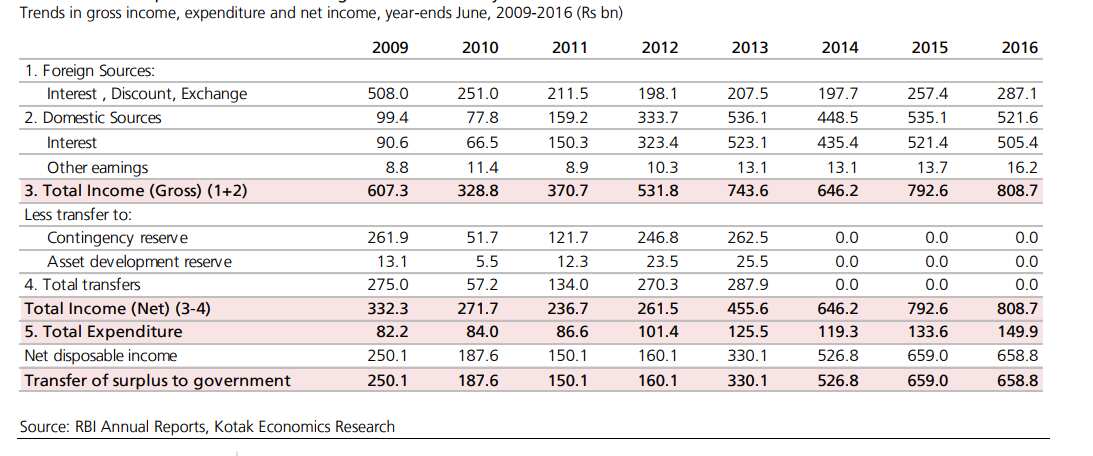 Let's first understand how RBI makes money
Let's first understand how RBI makes money
RBI's main source of income arises from interest earned on bond holdings through open market operations or purchase and sale of government securities.
After being nationalised - RBI has been transferring surplus (income over expenditure) to the government in accordance with Section 47 (Allocation of Surplus Profits) of the Reserve Bank of India Act, 1934.
This process is carried by the central board of the RBI in early August as it follows the accounting year July - June.
Why has RBI's surplus to government halved?
Madhavi Arora, Suvodeep Rakshit and Upasna Bhardwaj, analysts at Kotak Institutional Equities stated that they would await validation of this in RBI’s annual report, but lower RBI surplus is likely from costs of three things.
They are – PM Narendra Modi's demonetisation drive which banned 86% India's currency, printing of new notes and forward forex intervention.
Demonetisation exercise resulted in net loss of seigniorage to the RBI to the tune of Rs 15.44 lakh crore which were scrapped and needed printing after the deadline.
Seigniorage is the profit made by a Government by issuing currency, especially the difference between the face value of currency and their production costs.
According to the State Bank of India's research arm, ''The cost per piece might have increased in the span of 5 years. The number of incremental notes printed is taken at 5200 crore based on RBI indent estimates, RBI circular and our own internal estimates. Interestingly, RBI must have also printed Rs 1000 notes in the pre-demonetization period. This has also been taken into account while estimating the overall cost.”
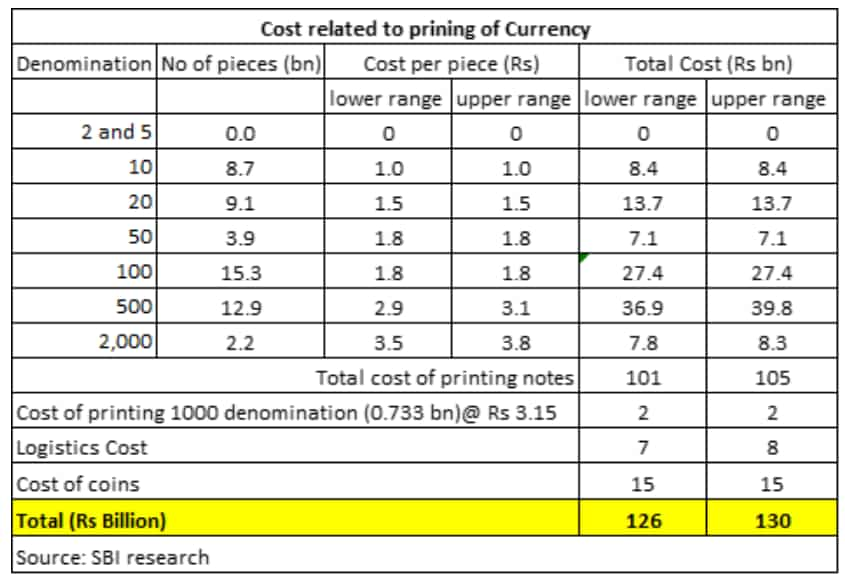
Approximate cost of printing each note of new Rs 500 currency would have cost RBI in the range of Rs 2.87 to Rs 3.09 and for Rs 2,000 notes between Rs 3.54 to Rs 3.77.
In regards to coin for Rs 10 coin the cost is assumed to be Rs 6. On a conservative basis total cost of minting coins is estimated at Rs 1,500 crore, stated SBI.
Thus total costs come out to be in the range of Rs 12,600 – Rs 13,000 crore.
SBI said, “Even if this figure reaches to 90%, it would translate into additional cost burden of Rs 500 crore or so, if we only print Rs 500 rupee notes. However, given that RBI is also printing Rs 200 rupee notes the there will be additional cost too.”
Liquidity surplus during demonetisation also forced RBI to resort to a combination of liquidity management tools like term reverse repos, Market Stabilisation Scheme (MSS), Cash Management Bills (CMB) and Open Market Operations (OMO) sale.
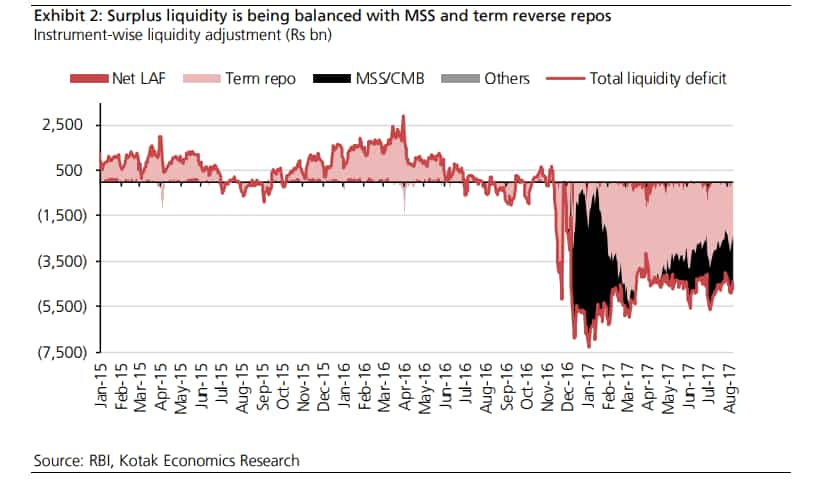
By end of FY17, a net sum of over Rs 139.71 lakh crore (Repo: Rs 21.70 lakh crore & Reverse Repo Rs 163.47 lakh crore) has been absorbed from the system through the LAF window.
Out of which, 90% has been absorbed in the post demonetization period (Nov’16 to Jun’17).
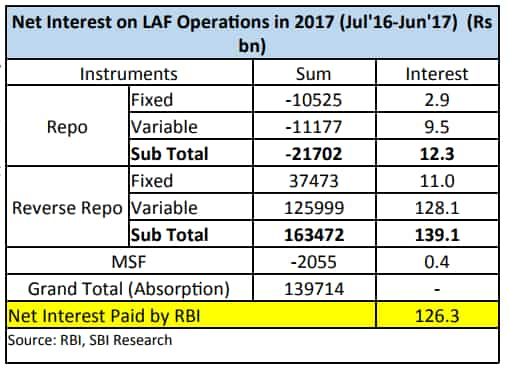
It is estimated that a net of Rs 12,600 crore interest has been foregone by RBI to banks in the LAF window.
RBI moved from being net short by Rs 740 crore in FY16 to net long by Rs 1,710 crore in FY17. Kotak Reseach said, "Further, USD weakness over the year would have led to some revaluation losses in RBI’s dollar denominated assets which may have been partly offset by the gains made in domestic assets due to the rally in bonds."
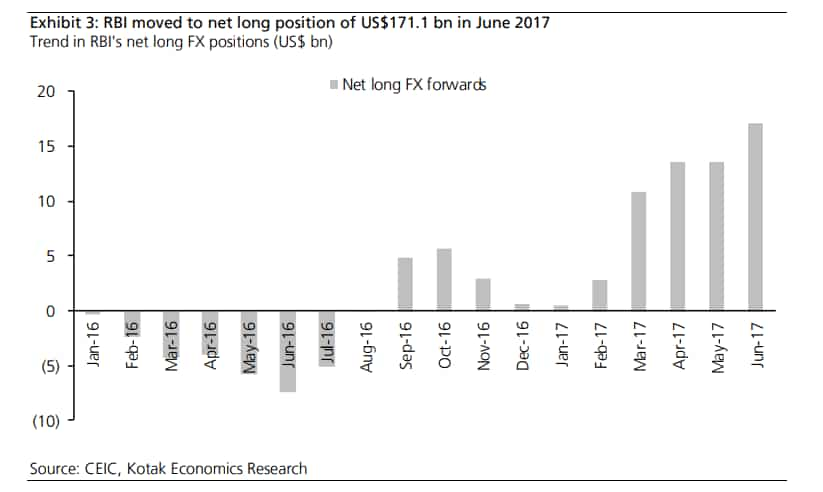
Fiscal Deficit?
Trio at Kotak said, "Lower RBI dividend disturbed the fiscal math (by 0.2% of GDP), but it is too early to determine the revenue side of the equation. We need to watch for cues from (1) direct tax collection (from higher filings), (2) indirect tax (GST) collections, and (3) any divestment upside."
SBI said, "Now this year though RBI is providing Rs 30,659 crore (around Rs 35,217 crore less than the last year) less, there is a possibility of incremental additional revenue of Rs 20,000 crore from direct taxes. This means that there may be a modest shortfall in revenue target of around Rs 1000— 15,000 crore."
On slippage arising after RBI’s dividend, Kotak further feels that this will pressurise the bond market.
"We believe this amount is minimal and could be mobilised by Government during the year and hence the headline fiscal deficit number at 3.2% will be met," said SBI.
ALSO READ:
Get Latest Business News, Stock Market Updates and Videos; Check your tax outgo through Income Tax Calculator and save money through our Personal Finance coverage. Check Business Breaking News Live on Zee Business Twitter and Facebook. Subscribe on YouTube.
05:06 PM IST











 Electricity distribution companies continue to remain a burden on state finances: RBI
Electricity distribution companies continue to remain a burden on state finances: RBI RBI imposes penalties on IndusInd Bank and Manappuram Finance for non-compliance of certain norms
RBI imposes penalties on IndusInd Bank and Manappuram Finance for non-compliance of certain norms Forex reserves drop $2 billion to $652.86 billion
Forex reserves drop $2 billion to $652.86 billion RBI flags rising subsidies by states as incipient stress
RBI flags rising subsidies by states as incipient stress Wholesale inflation eases to 1.89% in November from 2.36% in previous month
Wholesale inflation eases to 1.89% in November from 2.36% in previous month